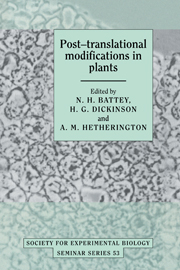Book contents
- Frontmatter
- Contents
- List of contributors
- List of abbreviations
- Preface
- Some roles of post-translational modifications in plants
- Signal transduction and protein phosphorylation in bacteria
- Roles of protein phosphorylation in animal cells
- The significance of post-translational modification of proteins by phosphorylation in the regulation of plant development and metabolism
- Post-translational modification of chloroplast proteins and the regulation of protein turnover
- Purification of a small phosphoprotein from chloroplasts and characterisation of its phosphoryl group
- Use of synthetic peptides to study G proteins and protein kinases within plant cells
- Activation of membrane-associated protein kinase by lipids, its substrates, and its function in signal transduction
- Distribution and function of Ca2+-dependent, calmodulin-independent protein kinases
- Phosphorylation of the plasma membrane proton pump
- The regulation of phosphoenolpyruvate carboxylase by reversible phosphorylation
- Protein phosphorylation and circadian rhythms
- Control of translation by phosphorylation of mRNP proteins in Fucus and Xenopus
- Regulation of plant metabolism by reversible protein (serine/threonine) phosphorylation
- Detection, biosynthesis and some functions of glycans N-linked to plant secreted proteins
- Biosynthesis, intracellular transport and processing of ricin
- Post-translational processing of concanavalin A
- The role of cell surface glycoproteins in differentiation and morphogenesis
- Ubiquitination of proteins during floral development and senescence
- Index
Purification of a small phosphoprotein from chloroplasts and characterisation of its phosphoryl group
Published online by Cambridge University Press: 06 July 2010
- Frontmatter
- Contents
- List of contributors
- List of abbreviations
- Preface
- Some roles of post-translational modifications in plants
- Signal transduction and protein phosphorylation in bacteria
- Roles of protein phosphorylation in animal cells
- The significance of post-translational modification of proteins by phosphorylation in the regulation of plant development and metabolism
- Post-translational modification of chloroplast proteins and the regulation of protein turnover
- Purification of a small phosphoprotein from chloroplasts and characterisation of its phosphoryl group
- Use of synthetic peptides to study G proteins and protein kinases within plant cells
- Activation of membrane-associated protein kinase by lipids, its substrates, and its function in signal transduction
- Distribution and function of Ca2+-dependent, calmodulin-independent protein kinases
- Phosphorylation of the plasma membrane proton pump
- The regulation of phosphoenolpyruvate carboxylase by reversible phosphorylation
- Protein phosphorylation and circadian rhythms
- Control of translation by phosphorylation of mRNP proteins in Fucus and Xenopus
- Regulation of plant metabolism by reversible protein (serine/threonine) phosphorylation
- Detection, biosynthesis and some functions of glycans N-linked to plant secreted proteins
- Biosynthesis, intracellular transport and processing of ricin
- Post-translational processing of concanavalin A
- The role of cell surface glycoproteins in differentiation and morphogenesis
- Ubiquitination of proteins during floral development and senescence
- Index
Summary
Introduction
The phosphorylation pattern of chloroplast proteins changes dramatically upon a switch in external conditions, e.g. a light–dark transition in vivo (Bennett, 1991) or a change in nucleoside triphosphate concentration in vitro (Ranjeva & Boudet, 1987). In the presence of very low concentrations of ATP or GTP (5–30 nm) and short labelling kinetics, only one protein of low molecular mass (about 19 kDa) is detected in soluble chloroplast proteins (Soll & Bennett, 1988; Soll, Berger & Bennett, 1989). This chapter describes the purification and analysis of this novel phosphoprotein.
Characterisation of the 19 kDa phosphoprotein
The 19 kDa protein was first detected as a phosphoprotein in highly purified intact chloroplasts from pea and spinach (Soll & Bennett, 1988). Upon subfractionation of chloroplasts on sucrose gradients, the phosphorylated protein could be detected in the total soluble extract of chloroplasts and the envelope membrane fraction. The total soluble extract contains stromal proteins as well as proteins from the intermembrane space, which are mostly liberated during lysis of the plastids. The hydrophilic nature of the 19 kDa protein was verified by Triton X-114/water phase partioning: the protein was exclusively found in the water phase. Mild sonication of mixed envelope membranes from chloroplasts also resulted in an almost complete release of the protein from the membrane. Differential labelling of the 19 kDa protein in intact and lysed chloroplasts of this soluble or peripheral membrane protein suggests its localisation outside the stromal space, perhaps in the inter-envelope lumen or the outer envelope membrane (Soll, Steidl & Schröder, 1991).
- Type
- Chapter
- Information
- Post-translational Modifications in Plants , pp. 79 - 90Publisher: Cambridge University PressPrint publication year: 1993



